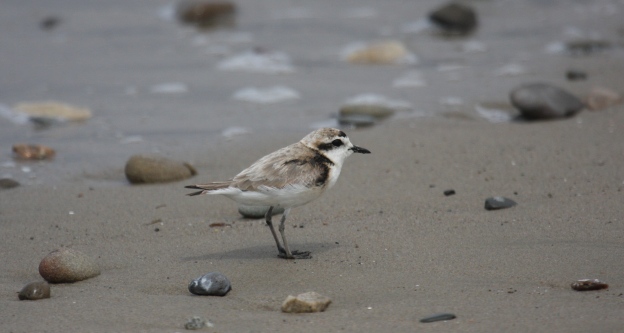A guest post by Ashley McConnell
The following post is one of a series previewing the research that will be presented at the in Sacramento, California (4–8 November 2018).
The Gaviota Coast in southern California is a precious resource to people and wildlife; a scenic stretch of coastline home to a wealth of biota, sand beaches, intact habitats, and natural drainages that allow the undisturbed flow of water between land and ocean. On 19 May 2015, eyes around the world turned to this stunning stretch of coastline, as newspapers and television screens flashed images of crude oil seeping into the waters of the Santa Barbara Channel.
It has been more than three years since an oil pipeline ruptured adjacent to Refugio State Beach near Santa Barbara, releasing more than 120,000 gallons of crude oil into a drainage ditch leading to the Pacific Ocean.

Staff from the California Office of Spill Prevention and Response and University of California collect invertebrate samples at Refugio State Beach one year after the spill as part of the Natural Resource Damage Assessment. Photo by CDFW/OSPR.
In the hours, days, weeks, months, and years following the spill, natural resource experts collected field data and samples to shed light on short-term and long-term impacts of the spill on different aspects of the area’s natural resources. That process is formally known as a Natural Resource Damage Assessment (NRDA).
Through the NRDA process, teams led by state and federal scientists diligently worked to quantify the injuries to fish, mammals, birds, and coastal habitats, as well as lost public use of those resources, with the goal of seeking compensation from the party responsible for the spill Learn more about the NRDA process.
As part of the assessment, teams conducted surveys to collect comparative data on three distinct but interconnected habitats within the impacted spill zone: sandy beach, subtidal, and rocky intertidal habitats. Biologists examined impacts to beach hopper populations in sandy beach habitats, organisms in rocky intertidal habitat, surfgrass in subtidal habitats, grunion spawning on the beaches, and surfperch in nearshore waters. Impacts to marine mammals and birds, such as the federally threatened Western Snowy Plover, were also quantified.
The Santa Barbara Channel region has natural seeps that release oil from the seafloor. Researchers applied a variety of forensic techniques to distinguish the spilled oil from natural seep oils. Careful analysis and interpretation of stranded oil, floating oil, and oil in water and tissues revealed the fate of the oil spilled from the pipeline. In the laboratory, toxicity tests using the pipeline oil were conducted with early life stages of invertebrates and fish. Results were used to assess potential effects of the spilled oil to these sensitive life stages. Overall, more than 50 studies were conducted to quantify injuries to wildlife, habitat, and lost human uses of these resources. This SETAC session, consisting of three poster and eight platform sessions will highlight this research.

U.S. Fish and Wildlife Service biologist documents wildlife impacts at Refugio State Beach in the early days of the Refugio oil spill as a flock of California brown pelicans skim the water in the background. Photo by USFWS.
Join representatives from the California Department of Fish and Wildlife, U.S. Fish and Wildlife Service, National Oceanic and Atmospheric Administration, and University of California Santa Barbara on 8 November to learn about the science behind the Natural Resource Damage Assessment for the Refugio oil spill.
Posters on display at 08:00 a.m. in Exhibit Hall
Marine mammal strandings following the 2015 Refugio Beach Oil Spill in Santa Barbara County, CA – Susan Chivers, National Oceanic and Atmospheric Administration
Toxicity of high energy water accommodated fractions of Refugio oil to sand crabs, blue mussels, and inland silversides – Stephen L. Clark, Pacific EcoRisk
Western snowy plover reproductive effects associated with the Refugio beach oil spill – Jenny Marek, U.S. Fish and Wildlife Service
Sessions begin at 13:00 p.m. in Room CC 203
13:00 Overview of impacts to natural resources from the Refugio Beach Oil Spill, Santa Barbara, California – Michael James Anderson, California Department of Fish and Wildlife, Office of Spill Prevention and Response
13:20 Applying multiple forensic tools to distinguish spilled pipeline oil from natural seeps following the Refugio Beach oil spill – David Valentine, University of California Santa Barbara
13:40 Polycyclic aromatic hydrocarbon uptake and forensic results in three beach invertebrate tissues and porewater – Refugio State Beach oil spill, 2015 – Bruce M. Joab, California Department of Fish and Wildlife, Office of Spill Prevention and Response
14:00 Population responses of sandy beach talitrid amphipods to the Refugio Beach Oil Spill, Santa Barbara County, 2015 – Jenny Dugan, University of California Santa Barbara
15:00 Development of a polycyclic aromatic hydrocarbon bioassay using sand crabs (Emerita analoga) following the Refugio Beach oil spill, Santa Barbara, CA – Bryand M. Duke, California Department of Fish and Wildlife, Office of Spill Prevention and Response
15:20 Surf zone water and beach porewater chemistry following the Refugio Beach oil spill indicate effects to fish and invertebrate early life stages – Regina M. Donohoe, California Department of Fish and Wildlife, Office of Spill Prevention and Response
15:40 Effects of oiling on the seagrass, Phyllospadix torreyi, as a result of the Refugio Beach Oil Spill, Santa Barbara County, 2015 – Natalie Cosentino-Manning, National Oceanic and Atmospheric Administration
16:00 Impact of the Refugio Beach oil spill on two surf zone fish: surfperch (Embiotocidae) and California grunion (Leuresthes tenuis) – David Witting, National Oceanic and Atmospheric Administration


You have discussed an interesting topic that everybody should know. Very well explained with examples. I have found a similar
website visit the site to know more about coopersenviro.